Work Based Assignment 1: Understanding Motivation and Performance
VerifiedAdded on 2023/01/19
|12
|2292
|75
Homework Assignment
AI Summary
This work-based assignment explores the concept of motivation within an organizational context. The assignment begins by defining motivation and highlighting its importance in driving employee actions and achieving organizational goals. It identifies key motivational factors such as job security, fair pay, and inspirational leadership. The assignment then delves into the vital factors for team management, including flexible work environments and meaningful work, and describes recognized theories of motivation like Maslow's and Herzberg's. It emphasizes the significance of a shared sense of purpose, the role of effective communication in establishing it, and the importance of leaders in motivating teams and individuals. The assignment also examines how individual differences affect motivation levels and the potential impact of low employee motivation on organizational performance. Finally, it explains the leader's role in supporting and developing the team, providing practical examples. The assignment uses references to support its claims.
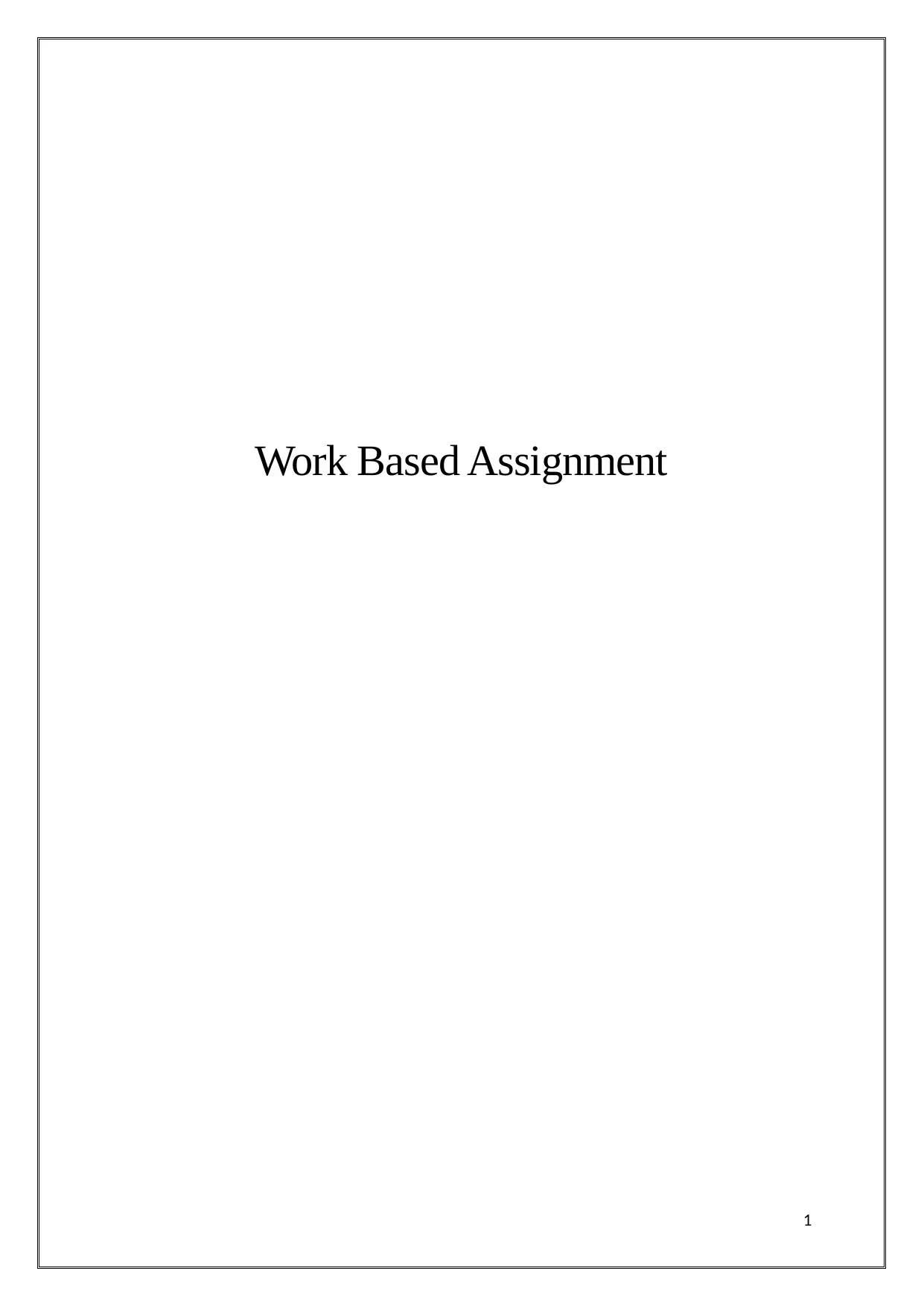
Work Based Assignment
1
1
Paraphrase This Document
Need a fresh take? Get an instant paraphrase of this document with our AI Paraphraser
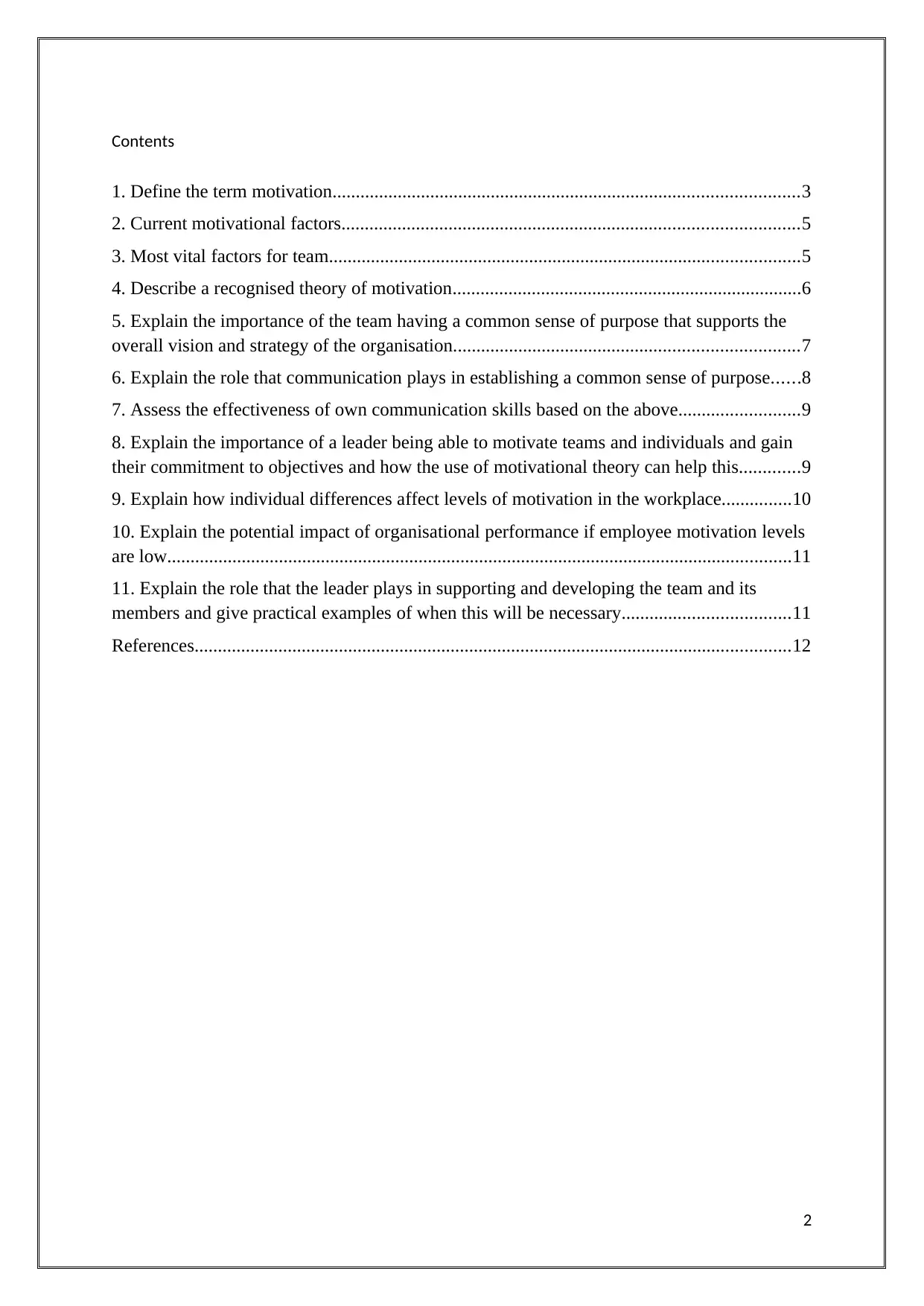
Contents
1. Define the term motivation....................................................................................................3
2. Current motivational factors..................................................................................................5
3. Most vital factors for team.....................................................................................................5
4. Describe a recognised theory of motivation...........................................................................6
5. Explain the importance of the team having a common sense of purpose that supports the
overall vision and strategy of the organisation..........................................................................7
6. Explain the role that communication plays in establishing a common sense of purpose......8
7. Assess the effectiveness of own communication skills based on the above..........................9
8. Explain the importance of a leader being able to motivate teams and individuals and gain
their commitment to objectives and how the use of motivational theory can help this.............9
9. Explain how individual differences affect levels of motivation in the workplace...............10
10. Explain the potential impact of organisational performance if employee motivation levels
are low......................................................................................................................................11
11. Explain the role that the leader plays in supporting and developing the team and its
members and give practical examples of when this will be necessary....................................11
References................................................................................................................................12
2
1. Define the term motivation....................................................................................................3
2. Current motivational factors..................................................................................................5
3. Most vital factors for team.....................................................................................................5
4. Describe a recognised theory of motivation...........................................................................6
5. Explain the importance of the team having a common sense of purpose that supports the
overall vision and strategy of the organisation..........................................................................7
6. Explain the role that communication plays in establishing a common sense of purpose......8
7. Assess the effectiveness of own communication skills based on the above..........................9
8. Explain the importance of a leader being able to motivate teams and individuals and gain
their commitment to objectives and how the use of motivational theory can help this.............9
9. Explain how individual differences affect levels of motivation in the workplace...............10
10. Explain the potential impact of organisational performance if employee motivation levels
are low......................................................................................................................................11
11. Explain the role that the leader plays in supporting and developing the team and its
members and give practical examples of when this will be necessary....................................11
References................................................................................................................................12
2
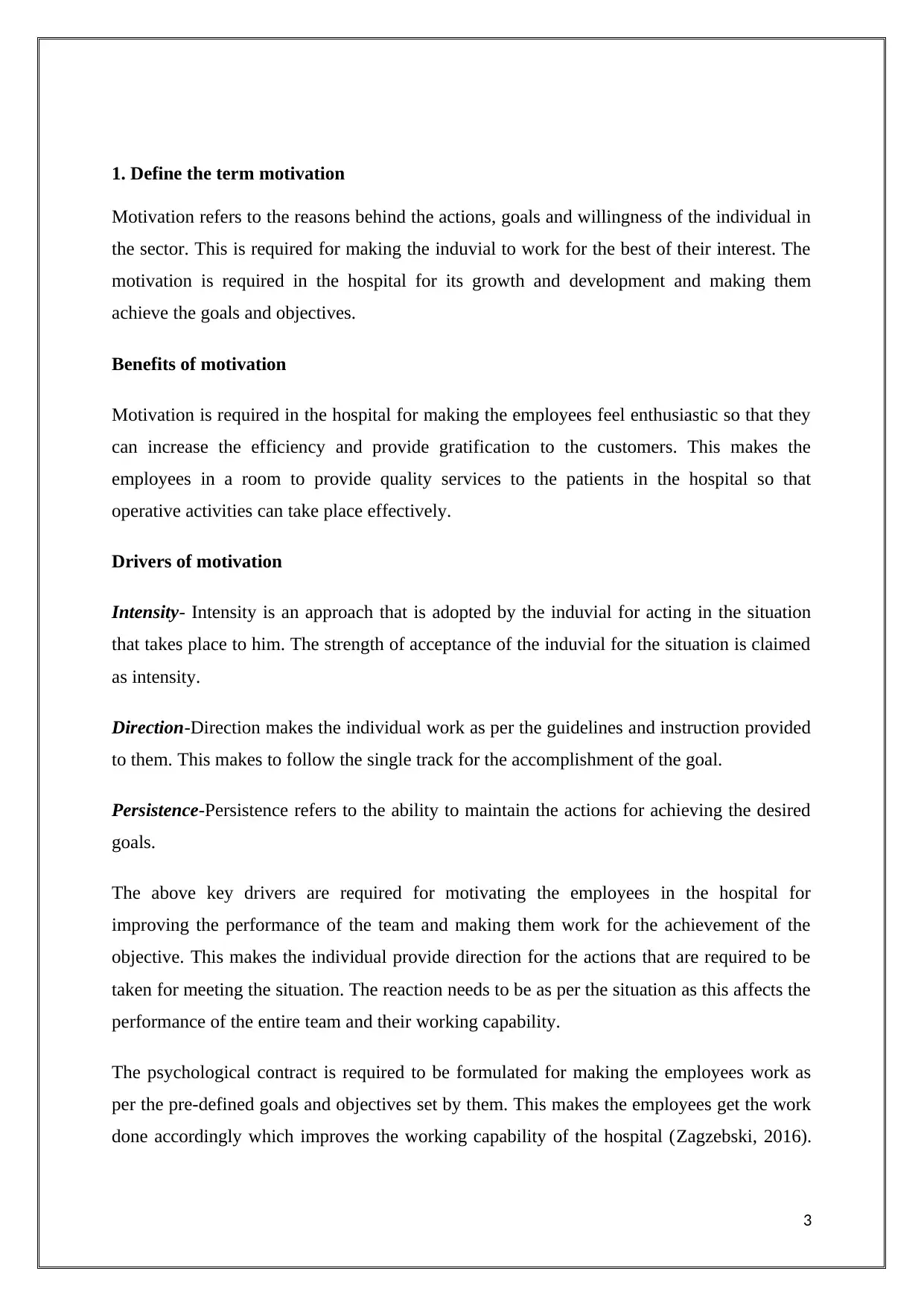
1. Define the term motivation
Motivation refers to the reasons behind the actions, goals and willingness of the individual in
the sector. This is required for making the induvial to work for the best of their interest. The
motivation is required in the hospital for its growth and development and making them
achieve the goals and objectives.
Benefits of motivation
Motivation is required in the hospital for making the employees feel enthusiastic so that they
can increase the efficiency and provide gratification to the customers. This makes the
employees in a room to provide quality services to the patients in the hospital so that
operative activities can take place effectively.
Drivers of motivation
Intensity- Intensity is an approach that is adopted by the induvial for acting in the situation
that takes place to him. The strength of acceptance of the induvial for the situation is claimed
as intensity.
Direction-Direction makes the individual work as per the guidelines and instruction provided
to them. This makes to follow the single track for the accomplishment of the goal.
Persistence-Persistence refers to the ability to maintain the actions for achieving the desired
goals.
The above key drivers are required for motivating the employees in the hospital for
improving the performance of the team and making them work for the achievement of the
objective. This makes the individual provide direction for the actions that are required to be
taken for meeting the situation. The reaction needs to be as per the situation as this affects the
performance of the entire team and their working capability.
The psychological contract is required to be formulated for making the employees work as
per the pre-defined goals and objectives set by them. This makes the employees get the work
done accordingly which improves the working capability of the hospital (Zagzebski, 2016).
3
Motivation refers to the reasons behind the actions, goals and willingness of the individual in
the sector. This is required for making the induvial to work for the best of their interest. The
motivation is required in the hospital for its growth and development and making them
achieve the goals and objectives.
Benefits of motivation
Motivation is required in the hospital for making the employees feel enthusiastic so that they
can increase the efficiency and provide gratification to the customers. This makes the
employees in a room to provide quality services to the patients in the hospital so that
operative activities can take place effectively.
Drivers of motivation
Intensity- Intensity is an approach that is adopted by the induvial for acting in the situation
that takes place to him. The strength of acceptance of the induvial for the situation is claimed
as intensity.
Direction-Direction makes the individual work as per the guidelines and instruction provided
to them. This makes to follow the single track for the accomplishment of the goal.
Persistence-Persistence refers to the ability to maintain the actions for achieving the desired
goals.
The above key drivers are required for motivating the employees in the hospital for
improving the performance of the team and making them work for the achievement of the
objective. This makes the individual provide direction for the actions that are required to be
taken for meeting the situation. The reaction needs to be as per the situation as this affects the
performance of the entire team and their working capability.
The psychological contract is required to be formulated for making the employees work as
per the pre-defined goals and objectives set by them. This makes the employees get the work
done accordingly which improves the working capability of the hospital (Zagzebski, 2016).
3
⊘ This is a preview!⊘
Do you want full access?
Subscribe today to unlock all pages.

Trusted by 1+ million students worldwide
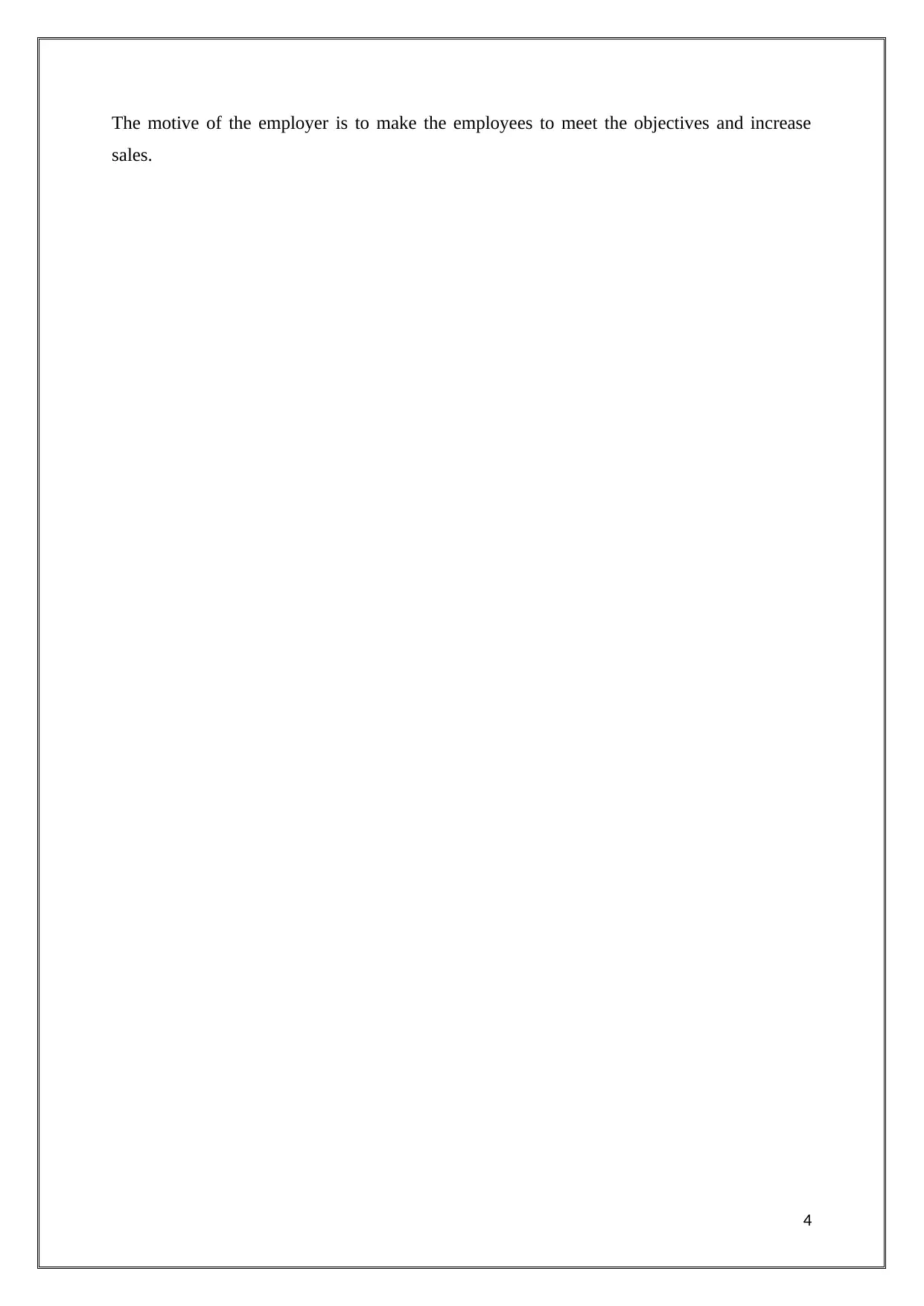
The motive of the employer is to make the employees to meet the objectives and increase
sales.
4
sales.
4
Paraphrase This Document
Need a fresh take? Get an instant paraphrase of this document with our AI Paraphraser

2.Current motivational factors
Various factors that are required to be taken into consideration for motivating the individuals
in the hospital for operation room management are-
Job security
Fair pay
Inspirational leadership
Fun
Meaning work
Cultural factors
Positive environment
Career perspective
Location
Flexible work
These factors are required in the hospitals for meeting the requirement of it and making the
best efforts for the achievement of gaols. The employees are made to be provided with
security for the job, fair pay, flexible work, positive environment etc. For increasing job
satisfaction. This makes the employees feel motivated for working for the best outcomes and
results in the business. This makes the employees have a clear perspective for the career for
the achievement of its goals (Nicholls, 2017).
3. Most vital factors for the team
The vital factors for the management of the team and increasing the motivation are flexible
work, easy pay, job security and meaningful work. The employees are to be provided with a
flexible work environment with the allocation of meaningful work so that they can achieve
with expert knowledge. This also makes them pay fair wages and security to the employees
for boosting their morale. This increases the productivity and efficiency of the employees and
team in the hospital (Lăzăroiu, 2015).
5
Various factors that are required to be taken into consideration for motivating the individuals
in the hospital for operation room management are-
Job security
Fair pay
Inspirational leadership
Fun
Meaning work
Cultural factors
Positive environment
Career perspective
Location
Flexible work
These factors are required in the hospitals for meeting the requirement of it and making the
best efforts for the achievement of gaols. The employees are made to be provided with
security for the job, fair pay, flexible work, positive environment etc. For increasing job
satisfaction. This makes the employees feel motivated for working for the best outcomes and
results in the business. This makes the employees have a clear perspective for the career for
the achievement of its goals (Nicholls, 2017).
3. Most vital factors for the team
The vital factors for the management of the team and increasing the motivation are flexible
work, easy pay, job security and meaningful work. The employees are to be provided with a
flexible work environment with the allocation of meaningful work so that they can achieve
with expert knowledge. This also makes them pay fair wages and security to the employees
for boosting their morale. This increases the productivity and efficiency of the employees and
team in the hospital (Lăzăroiu, 2015).
5

4. Describe a recognised theory of motivation
The two main theories need to be taken into consideration for improving the motivation that
Maslow’s motivation theory and Herzberg theory. Maslow’s theory of motivation defines that
the motivation could be availed to the people with the fulfilment of basic needs. The needs
are to be fulfilled as per the requirement of the individual in respect of psychological needs,
safety, belonging, esteem and self-actualization. On the other hand, Herzberg motivational
theory depends on two factors that are hygiene factors and motivators. Hygiene factors
involve status, job security, pay, fringe benefits etc. While the motivators are recognition,
sense of achievement, responsivity etc. This also increases team performance and it results in
terms of the work and services (Velmurugan and Sankar, 2017).
5. Explain the importance of the team having a common sense of purpose that supports
the overall vision and strategy of the organisation.
The common sense for the purpose is required in the hospital for achieving the objective that
is set by the leaders. The vision and strategy set by the leaders need to clear and
communicated to the team so that they can work on that in an appropriate manner. This
makes the leaders influence and guides the team members to work for the interest of
customers and organisation. The strategy and vision need to be as per the requirement of the
hospital for earning profits and proving the quality services to the customers. The objectives
set by the hospital needs to be specific, measurable, achievable, relevant and time-oriented so
that it could be achieved easily (Deci and Ryan, 2010).
6
The two main theories need to be taken into consideration for improving the motivation that
Maslow’s motivation theory and Herzberg theory. Maslow’s theory of motivation defines that
the motivation could be availed to the people with the fulfilment of basic needs. The needs
are to be fulfilled as per the requirement of the individual in respect of psychological needs,
safety, belonging, esteem and self-actualization. On the other hand, Herzberg motivational
theory depends on two factors that are hygiene factors and motivators. Hygiene factors
involve status, job security, pay, fringe benefits etc. While the motivators are recognition,
sense of achievement, responsivity etc. This also increases team performance and it results in
terms of the work and services (Velmurugan and Sankar, 2017).
5. Explain the importance of the team having a common sense of purpose that supports
the overall vision and strategy of the organisation.
The common sense for the purpose is required in the hospital for achieving the objective that
is set by the leaders. The vision and strategy set by the leaders need to clear and
communicated to the team so that they can work on that in an appropriate manner. This
makes the leaders influence and guides the team members to work for the interest of
customers and organisation. The strategy and vision need to be as per the requirement of the
hospital for earning profits and proving the quality services to the customers. The objectives
set by the hospital needs to be specific, measurable, achievable, relevant and time-oriented so
that it could be achieved easily (Deci and Ryan, 2010).
6
⊘ This is a preview!⊘
Do you want full access?
Subscribe today to unlock all pages.

Trusted by 1+ million students worldwide

6. Explain the role that communication plays in establishing a common sense of purpose
Communication plays a measurable role in the achievement of objectives and purpose that
are set by the managers. The leaders are required to communicate the thing to the employees
in clear, concise, consistent and the correct manner. The messages need to be transmitted
through different mode of channels so that they could be understood by the individuals in the
hospitals. The communication will also help in making the employees to put their best foot
forward for providing the quality services to the customers. This also helps in meeting with
the purpose that is set by them (Albrecht, Bakker, Gruman, Macey & Saks, 2015).
7. Assess the effectiveness of own communication skills based on the above
The communication skills will help in making the employees work for the objectives of
business so that they can meet with its requirements. My communication skills will help in
delivering the best results from the employees by making the employee with clear and
competent objectives. This will also help in knowing the weakness and strength of employees
so that actions could be taken for their improvement. This will make the employees share
their problems so that it could be resolved on time by the management. The communication
skills play an effective role in the growth of the business and developing the business as per
the requirement. This also establishes good relations among the employees and customers
(Bailey, Madden, Alfes & Fletcher, 2015).
7
Communication plays a measurable role in the achievement of objectives and purpose that
are set by the managers. The leaders are required to communicate the thing to the employees
in clear, concise, consistent and the correct manner. The messages need to be transmitted
through different mode of channels so that they could be understood by the individuals in the
hospitals. The communication will also help in making the employees to put their best foot
forward for providing the quality services to the customers. This also helps in meeting with
the purpose that is set by them (Albrecht, Bakker, Gruman, Macey & Saks, 2015).
7. Assess the effectiveness of own communication skills based on the above
The communication skills will help in making the employees work for the objectives of
business so that they can meet with its requirements. My communication skills will help in
delivering the best results from the employees by making the employee with clear and
competent objectives. This will also help in knowing the weakness and strength of employees
so that actions could be taken for their improvement. This will make the employees share
their problems so that it could be resolved on time by the management. The communication
skills play an effective role in the growth of the business and developing the business as per
the requirement. This also establishes good relations among the employees and customers
(Bailey, Madden, Alfes & Fletcher, 2015).
7
Paraphrase This Document
Need a fresh take? Get an instant paraphrase of this document with our AI Paraphraser
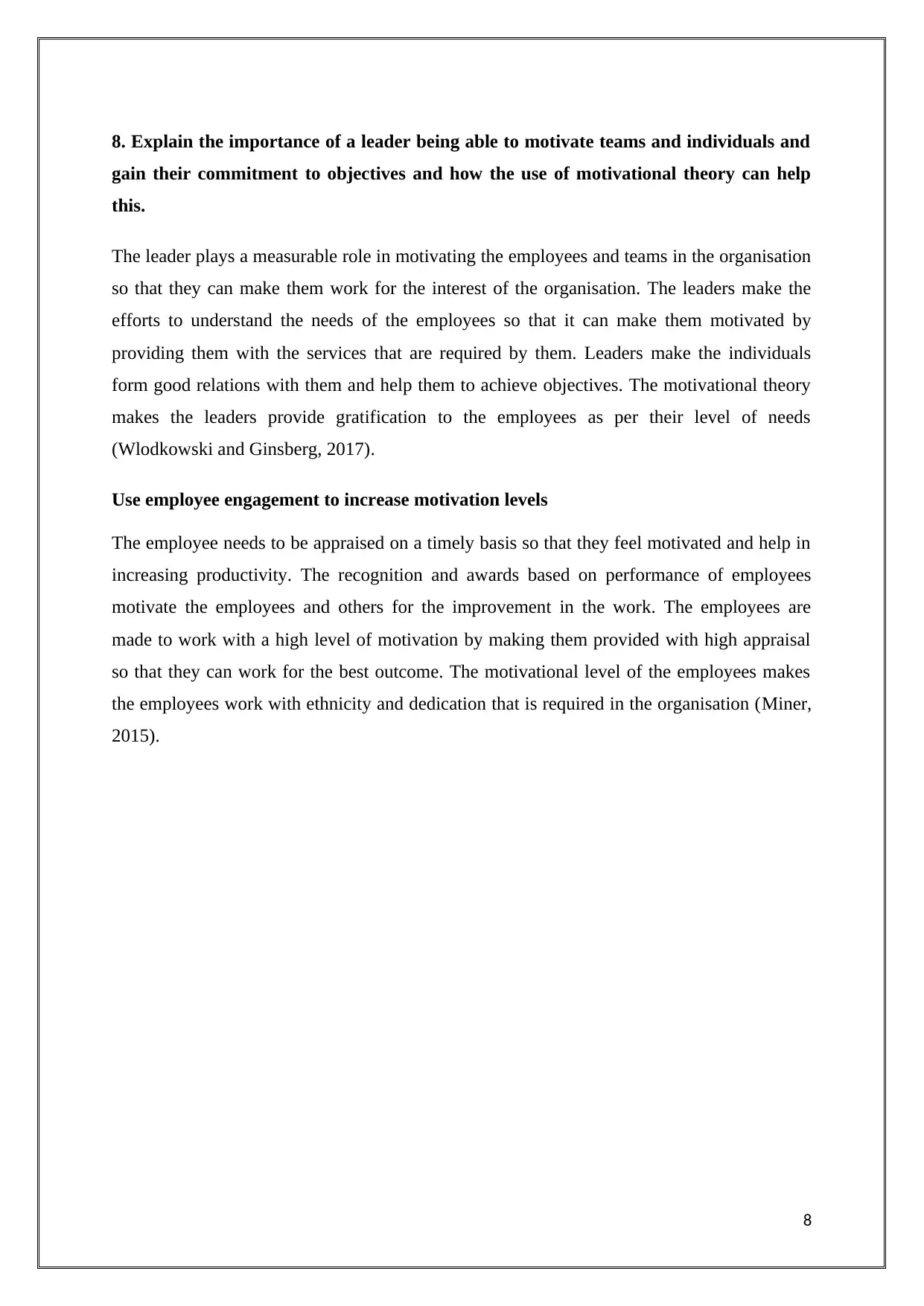
8. Explain the importance of a leader being able to motivate teams and individuals and
gain their commitment to objectives and how the use of motivational theory can help
this.
The leader plays a measurable role in motivating the employees and teams in the organisation
so that they can make them work for the interest of the organisation. The leaders make the
efforts to understand the needs of the employees so that it can make them motivated by
providing them with the services that are required by them. Leaders make the individuals
form good relations with them and help them to achieve objectives. The motivational theory
makes the leaders provide gratification to the employees as per their level of needs
(Wlodkowski and Ginsberg, 2017).
Use employee engagement to increase motivation levels
The employee needs to be appraised on a timely basis so that they feel motivated and help in
increasing productivity. The recognition and awards based on performance of employees
motivate the employees and others for the improvement in the work. The employees are
made to work with a high level of motivation by making them provided with high appraisal
so that they can work for the best outcome. The motivational level of the employees makes
the employees work with ethnicity and dedication that is required in the organisation (Miner,
2015).
8
gain their commitment to objectives and how the use of motivational theory can help
this.
The leader plays a measurable role in motivating the employees and teams in the organisation
so that they can make them work for the interest of the organisation. The leaders make the
efforts to understand the needs of the employees so that it can make them motivated by
providing them with the services that are required by them. Leaders make the individuals
form good relations with them and help them to achieve objectives. The motivational theory
makes the leaders provide gratification to the employees as per their level of needs
(Wlodkowski and Ginsberg, 2017).
Use employee engagement to increase motivation levels
The employee needs to be appraised on a timely basis so that they feel motivated and help in
increasing productivity. The recognition and awards based on performance of employees
motivate the employees and others for the improvement in the work. The employees are
made to work with a high level of motivation by making them provided with high appraisal
so that they can work for the best outcome. The motivational level of the employees makes
the employees work with ethnicity and dedication that is required in the organisation (Miner,
2015).
8
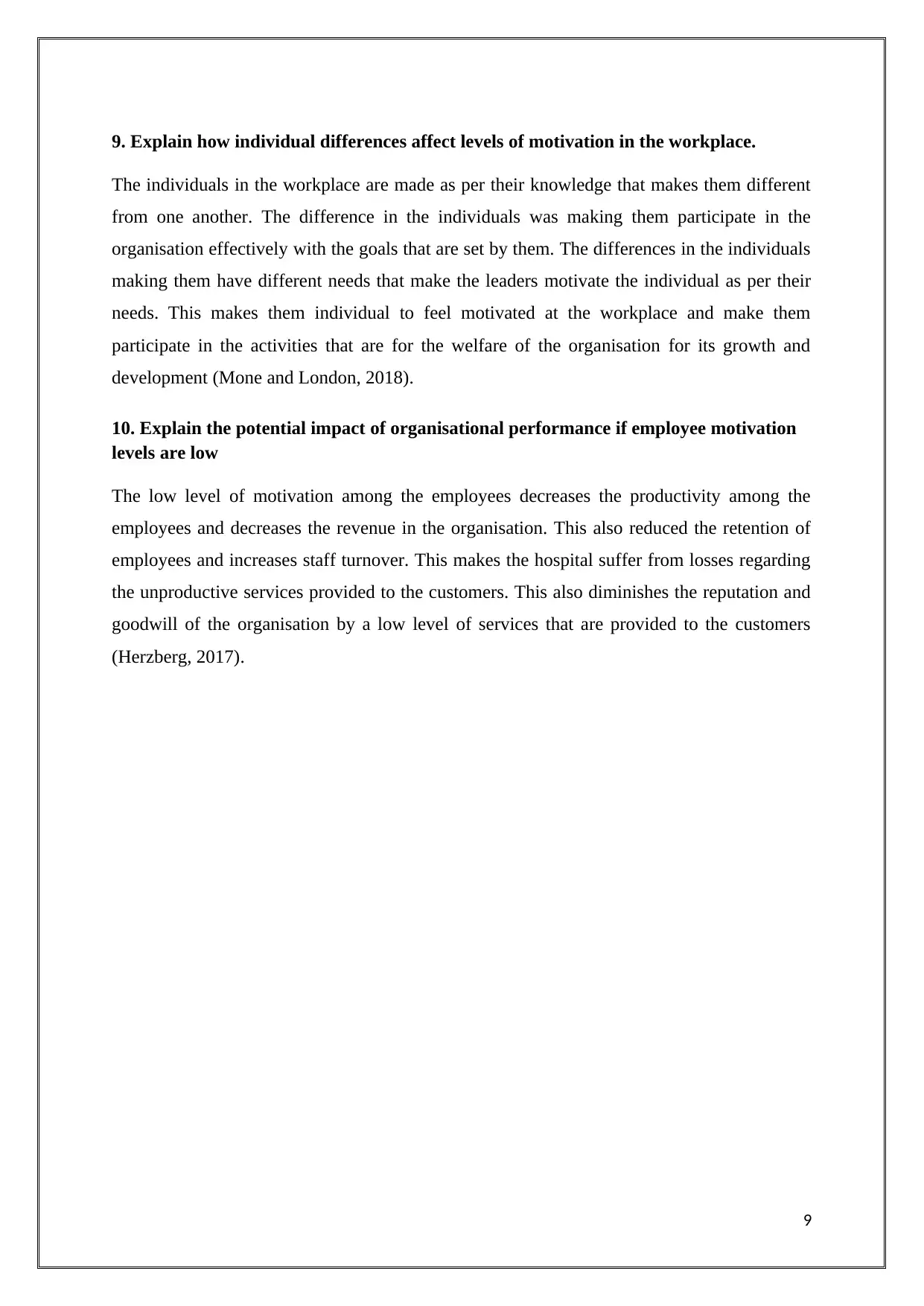
9. Explain how individual differences affect levels of motivation in the workplace.
The individuals in the workplace are made as per their knowledge that makes them different
from one another. The difference in the individuals was making them participate in the
organisation effectively with the goals that are set by them. The differences in the individuals
making them have different needs that make the leaders motivate the individual as per their
needs. This makes them individual to feel motivated at the workplace and make them
participate in the activities that are for the welfare of the organisation for its growth and
development (Mone and London, 2018).
10. Explain the potential impact of organisational performance if employee motivation
levels are low
The low level of motivation among the employees decreases the productivity among the
employees and decreases the revenue in the organisation. This also reduced the retention of
employees and increases staff turnover. This makes the hospital suffer from losses regarding
the unproductive services provided to the customers. This also diminishes the reputation and
goodwill of the organisation by a low level of services that are provided to the customers
(Herzberg, 2017).
9
The individuals in the workplace are made as per their knowledge that makes them different
from one another. The difference in the individuals was making them participate in the
organisation effectively with the goals that are set by them. The differences in the individuals
making them have different needs that make the leaders motivate the individual as per their
needs. This makes them individual to feel motivated at the workplace and make them
participate in the activities that are for the welfare of the organisation for its growth and
development (Mone and London, 2018).
10. Explain the potential impact of organisational performance if employee motivation
levels are low
The low level of motivation among the employees decreases the productivity among the
employees and decreases the revenue in the organisation. This also reduced the retention of
employees and increases staff turnover. This makes the hospital suffer from losses regarding
the unproductive services provided to the customers. This also diminishes the reputation and
goodwill of the organisation by a low level of services that are provided to the customers
(Herzberg, 2017).
9
⊘ This is a preview!⊘
Do you want full access?
Subscribe today to unlock all pages.

Trusted by 1+ million students worldwide

11. Explain the role that the leader plays in supporting and developing the team and its
members and give practical examples of when this will be necessary
Leaders are essential in the organisation for the growth and development of it as this help in
giving the employees the best feedback by improving their mind for creativity, generating
new ideas and opinions. The recognition and appraisal for the employee make them work
with dedication and best efforts. The employees are motivated to achieving their personal
goal and organisational goal so that they can meet the goals and objectives. For example, the
appraisal provided to the employee for the achievement of his target enhances the
motivational level of other employees in the organisation (Cohen, 2017).
10
members and give practical examples of when this will be necessary
Leaders are essential in the organisation for the growth and development of it as this help in
giving the employees the best feedback by improving their mind for creativity, generating
new ideas and opinions. The recognition and appraisal for the employee make them work
with dedication and best efforts. The employees are motivated to achieving their personal
goal and organisational goal so that they can meet the goals and objectives. For example, the
appraisal provided to the employee for the achievement of his target enhances the
motivational level of other employees in the organisation (Cohen, 2017).
10
Paraphrase This Document
Need a fresh take? Get an instant paraphrase of this document with our AI Paraphraser
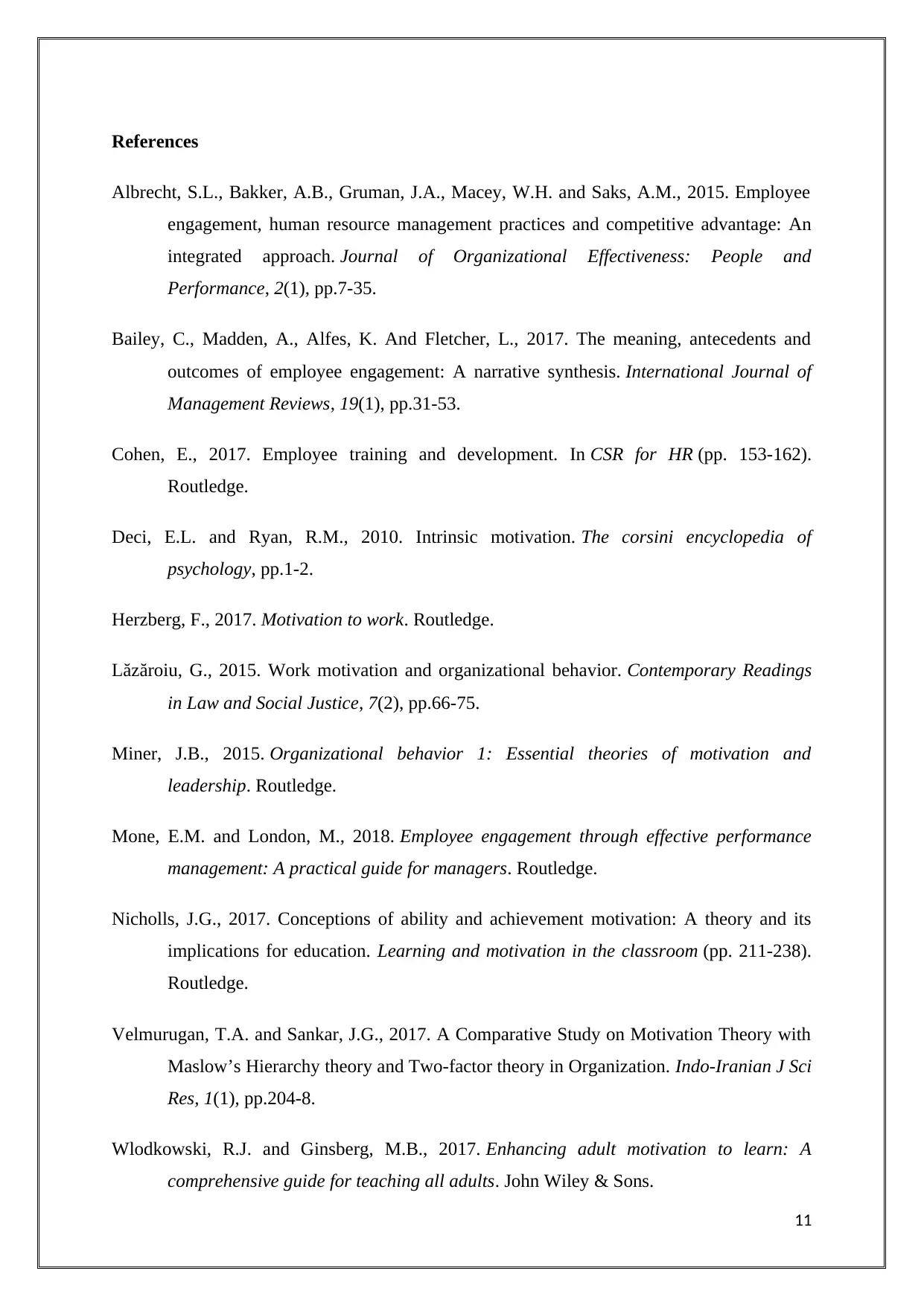
References
Albrecht, S.L., Bakker, A.B., Gruman, J.A., Macey, W.H. and Saks, A.M., 2015. Employee
engagement, human resource management practices and competitive advantage: An
integrated approach. Journal of Organizational Effectiveness: People and
Performance, 2(1), pp.7-35.
Bailey, C., Madden, A., Alfes, K. And Fletcher, L., 2017. The meaning, antecedents and
outcomes of employee engagement: A narrative synthesis. International Journal of
Management Reviews, 19(1), pp.31-53.
Cohen, E., 2017. Employee training and development. In CSR for HR (pp. 153-162).
Routledge.
Deci, E.L. and Ryan, R.M., 2010. Intrinsic motivation. The corsini encyclopedia of
psychology, pp.1-2.
Herzberg, F., 2017. Motivation to work. Routledge.
Lăzăroiu, G., 2015. Work motivation and organizational behavior. Contemporary Readings
in Law and Social Justice, 7(2), pp.66-75.
Miner, J.B., 2015. Organizational behavior 1: Essential theories of motivation and
leadership. Routledge.
Mone, E.M. and London, M., 2018. Employee engagement through effective performance
management: A practical guide for managers. Routledge.
Nicholls, J.G., 2017. Conceptions of ability and achievement motivation: A theory and its
implications for education. Learning and motivation in the classroom (pp. 211-238).
Routledge.
Velmurugan, T.A. and Sankar, J.G., 2017. A Comparative Study on Motivation Theory with
Maslow’s Hierarchy theory and Two-factor theory in Organization. Indo-Iranian J Sci
Res, 1(1), pp.204-8.
Wlodkowski, R.J. and Ginsberg, M.B., 2017. Enhancing adult motivation to learn: A
comprehensive guide for teaching all adults. John Wiley & Sons.
11
Albrecht, S.L., Bakker, A.B., Gruman, J.A., Macey, W.H. and Saks, A.M., 2015. Employee
engagement, human resource management practices and competitive advantage: An
integrated approach. Journal of Organizational Effectiveness: People and
Performance, 2(1), pp.7-35.
Bailey, C., Madden, A., Alfes, K. And Fletcher, L., 2017. The meaning, antecedents and
outcomes of employee engagement: A narrative synthesis. International Journal of
Management Reviews, 19(1), pp.31-53.
Cohen, E., 2017. Employee training and development. In CSR for HR (pp. 153-162).
Routledge.
Deci, E.L. and Ryan, R.M., 2010. Intrinsic motivation. The corsini encyclopedia of
psychology, pp.1-2.
Herzberg, F., 2017. Motivation to work. Routledge.
Lăzăroiu, G., 2015. Work motivation and organizational behavior. Contemporary Readings
in Law and Social Justice, 7(2), pp.66-75.
Miner, J.B., 2015. Organizational behavior 1: Essential theories of motivation and
leadership. Routledge.
Mone, E.M. and London, M., 2018. Employee engagement through effective performance
management: A practical guide for managers. Routledge.
Nicholls, J.G., 2017. Conceptions of ability and achievement motivation: A theory and its
implications for education. Learning and motivation in the classroom (pp. 211-238).
Routledge.
Velmurugan, T.A. and Sankar, J.G., 2017. A Comparative Study on Motivation Theory with
Maslow’s Hierarchy theory and Two-factor theory in Organization. Indo-Iranian J Sci
Res, 1(1), pp.204-8.
Wlodkowski, R.J. and Ginsberg, M.B., 2017. Enhancing adult motivation to learn: A
comprehensive guide for teaching all adults. John Wiley & Sons.
11
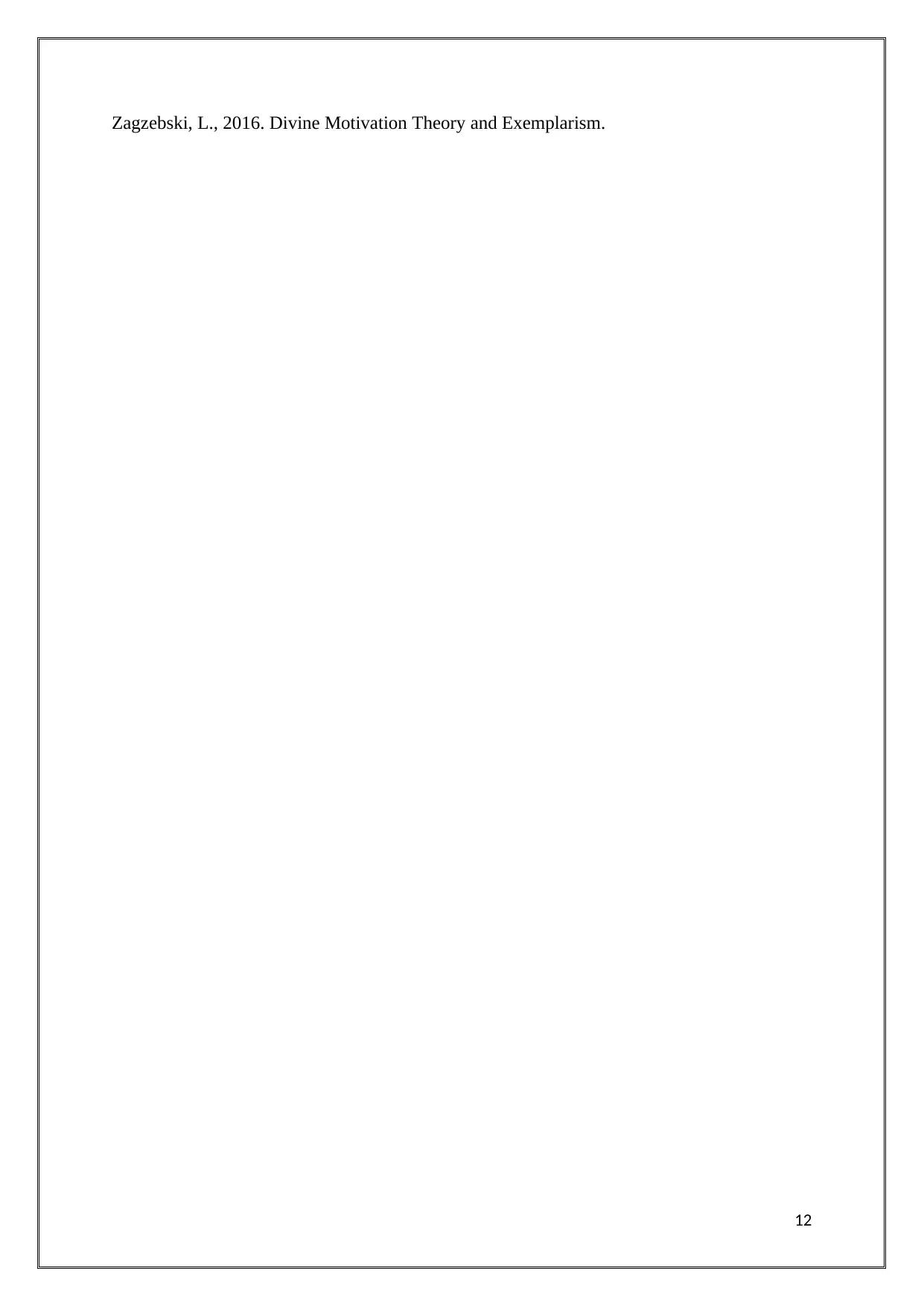
Zagzebski, L., 2016. Divine Motivation Theory and Exemplarism.
12
12
⊘ This is a preview!⊘
Do you want full access?
Subscribe today to unlock all pages.

Trusted by 1+ million students worldwide
1 out of 12
Related Documents
Your All-in-One AI-Powered Toolkit for Academic Success.
+13062052269
info@desklib.com
Available 24*7 on WhatsApp / Email
![[object Object]](/_next/static/media/star-bottom.7253800d.svg)
Unlock your academic potential
Copyright © 2020–2025 A2Z Services. All Rights Reserved. Developed and managed by ZUCOL.




